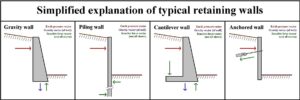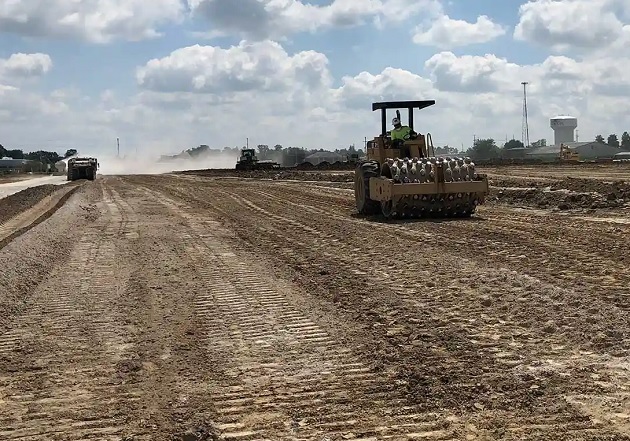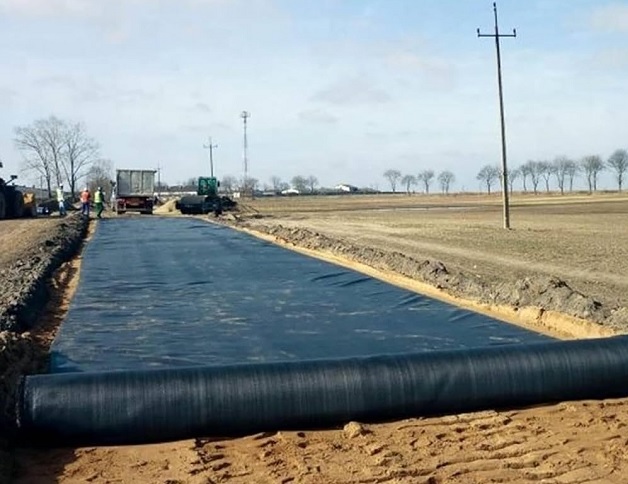Retaining Wall – Definition and Types of Retaining Walls
A retaining wall is a vertical or near-vertical structure designed to resist the lateral pressure of soil when there is a change in ground elevation. These walls are used to hold back or “retain” soil or other materials and prevent them from eroding, collapsing, or sliding downhill. Retaining walls are a common feature in civil engineering, landscaping, and construction and serve various purposes, including:
1. **Erosion Control:** Retaining walls can prevent soil erosion on slopes and hillsides by holding the soil in place and preventing it from being washed away by rain or runoff.
2. **Slope Stabilization:** They provide stability to steep or uneven terrain by preventing landslides or slope failures.
3. **Terracing:** Retaining walls can create flat or gently sloping terraced areas on sloped land, which are ideal for landscaping, agriculture, or building structures.
4. **Land Use Optimization:** In urban and suburban areas, retaining walls allow for the optimal use of limited space by creating level areas for roads, buildings, and other structures.
5. **Foundation Protection:** Retaining walls can protect structures like homes and buildings from the pressure and potential damage caused by shifting soil and groundwater.
6. **Aesthetic Purposes:** In landscaping and architecture, retaining walls are often used for aesthetic reasons, creating visually appealing elements in gardens, parks, and hardscapes.
Types of Retaining wall
Retaining walls come in various types, each designed to suit specific needs and conditions. The choice of retaining wall type depends on factors such as the height of the wall, soil characteristics, aesthetics, and budget. Here are some common types of retaining walls:

-
Gravity Retaining Wall:
- Relies on its own weight to resist the pressure of the retained soil.
- Typically made from materials like concrete, stone, or masonry.
- Suitable for lower walls and where soil loads are not excessive.
-
Cantilever Retaining Wall:
- Utilizes a large concrete slab or footing that extends into the retained soil.
- Has a thin vertical wall portion that resists the soil pressure.
- Requires careful engineering to balance loads and prevent tipping.
-
Anchored Retaining Wall:
- Uses cables or other reinforcing elements anchored into the soil behind the wall.
- Provides additional stability for taller walls or in challenging soil conditions.
- Commonly used in combination with other wall types.
-
Sheet Pile Retaining Wall:
- Comprises interlocking steel, vinyl, or wood sheets driven into the ground.
- Suitable for preventing water infiltration or in locations with limited space.
- Often used in waterfront or marine applications.
-
Gabion Retaining Wall:
- Consists of wire mesh containers (gabion baskets) filled with rocks or gravel.
- Offers good drainage and is visually attractive.
- Used in landscaping and erosion control.
-
Reinforced Soil Retaining Wall (Mechanically Stabilized Earth – MSE):
- Combines soil and geosynthetic reinforcements (such as geogrids) to create a stable structure.
- Versatile and cost-effective for a wide range of wall heights and soil conditions.
- Commonly used for highway and infrastructure projects.
-
Segmental Retaining Wall:
- Comprises precast concrete or modular blocks stacked and interlocked.
- Easy to install and can create visually appealing walls.
- Suitable for walls of moderate height.
-
Counterfort Retaining Wall:
- Similar to the cantilever wall but features vertical concrete webs (counterforts) on the backside of the wall.
- Provides additional support for taller walls and larger soil loads.
-
Hybrid Retaining Wall:
- Combines features of different retaining wall types to address specific project requirements.
- Customized solutions that offer flexibility in design and construction.
The choice of the appropriate retaining wall type should consider factors like the site’s geotechnical conditions, the height of the wall, drainage requirements, aesthetics, and cost. Consulting with a qualified engineer or geotechnical expert is crucial when designing and constructing retaining walls to ensure they are safe, durable, and effective for their intended purpose.
Retaining walls come in various materials and designs, including concrete, stone, wood, and modular block systems. The choice of material and design depends on factors such as the height of the wall, the soil conditions, and the desired aesthetics.
Proper design and construction of retaining walls are essential to ensure their stability and longevity. Engineers and contractors consider factors like the type of soil, the wall’s height, drainage, and the required structural reinforcement to create effective and safe retaining walls.


